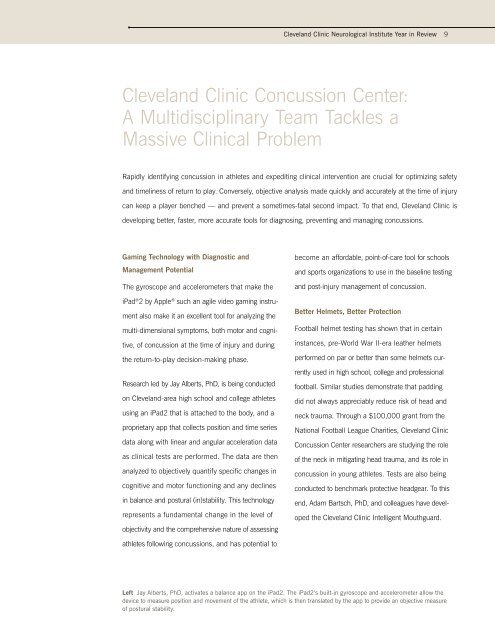Neurological Institute - Cleveland Clinic - Cleveland Clinic Home
Neurological Institute - Cleveland Clinic - Cleveland Clinic Home
Neurological Institute - Cleveland Clinic - Cleveland Clinic Home
You also want an ePaper? Increase the reach of your titles
YUMPU automatically turns print PDFs into web optimized ePapers that Google loves.
<strong>Cleveland</strong> <strong>Clinic</strong> <strong>Neurological</strong> <strong>Institute</strong> Year in Review 9<br />
<strong>Cleveland</strong> <strong>Clinic</strong> Concussion Center:<br />
A Multidisciplinary Team Tackles a<br />
Massive <strong>Clinic</strong>al Problem<br />
Rapidly identifying concussion in athletes and expediting clinical intervention are crucial for optimizing safety<br />
and timeliness of return to play. Conversely, objective analysis made quickly and accurately at the time of injury<br />
can keep a player benched — and prevent a sometimes-fatal second impact. To that end, <strong>Cleveland</strong> <strong>Clinic</strong> is<br />
developing better, faster, more accurate tools for diagnosing, preventing and managing concussions.<br />
Gaming Technology with Diagnostic and<br />
Management Potential<br />
The gyroscope and accelerometers that make the<br />
iPad ® 2 by Apple ® such an agile video gaming instru-<br />
ment also make it an excellent tool for analyzing the<br />
multi-dimensional symptoms, both motor and cogni-<br />
tive, of concussion at the time of injury and during<br />
the return-to-play decision-making phase.<br />
Research led by Jay Alberts, PhD, is being conducted<br />
on <strong>Cleveland</strong>-area high school and college athletes<br />
using an iPad2 that is attached to the body, and a<br />
proprietary app that collects position and time series<br />
data along with linear and angular acceleration data<br />
as clinical tests are performed. The data are then<br />
analyzed to objectively quantify specific changes in<br />
cognitive and motor functioning and any declines<br />
in balance and postural (in)stability. This technology<br />
represents a fundamental change in the level of<br />
objectivity and the comprehensive nature of assessing<br />
athletes following concussions, and has potential to<br />
become an affordable, point-of-care tool for schools<br />
and sports organizations to use in the baseline testing<br />
and post-injury management of concussion.<br />
Better Helmets, Better Protection<br />
Football helmet testing has shown that in certain<br />
instances, pre-World War II-era leather helmets<br />
performed on par or better than some helmets cur-<br />
rently used in high school, college and professional<br />
football. Similar studies demonstrate that padding<br />
did not always appreciably reduce risk of head and<br />
neck trauma. Through a $100,000 grant from the<br />
National Football League Charities, <strong>Cleveland</strong> <strong>Clinic</strong><br />
Concussion Center researchers are studying the role<br />
of the neck in mitigating head trauma, and its role in<br />
concussion in young athletes. Tests are also being<br />
conducted to benchmark protective headgear. To this<br />
end, Adam Bartsch, PhD, and colleagues have devel-<br />
oped the <strong>Cleveland</strong> <strong>Clinic</strong> Intelligent Mouthguard.<br />
Left Jay Alberts, PhD, activates a balance app on the iPad2. The iPad2’s built-in gyroscope and accelerometer allow the<br />
device to measure position and movement of the athlete, which is then translated by the app to provide an objective measure<br />
of postural stability.

















